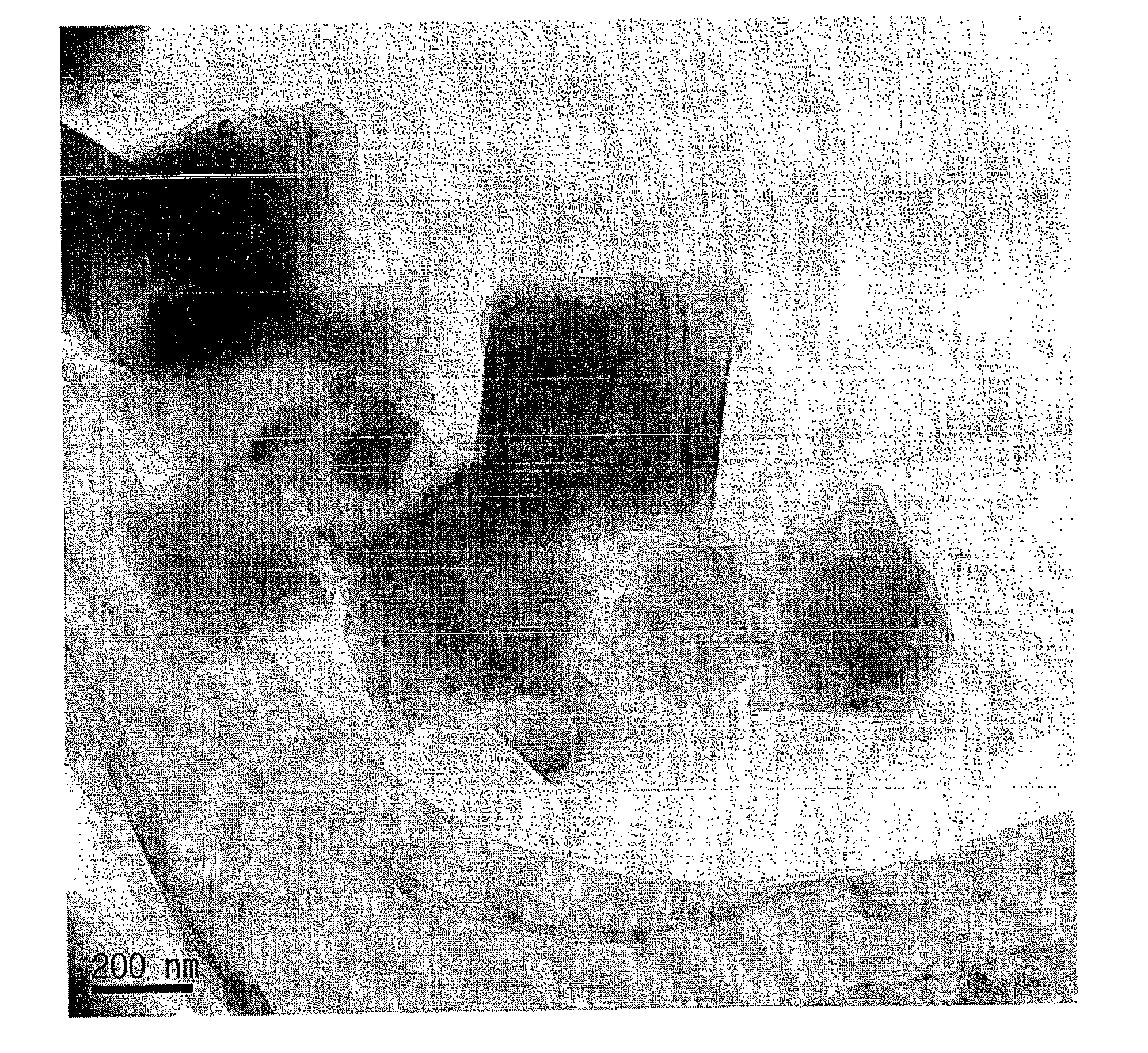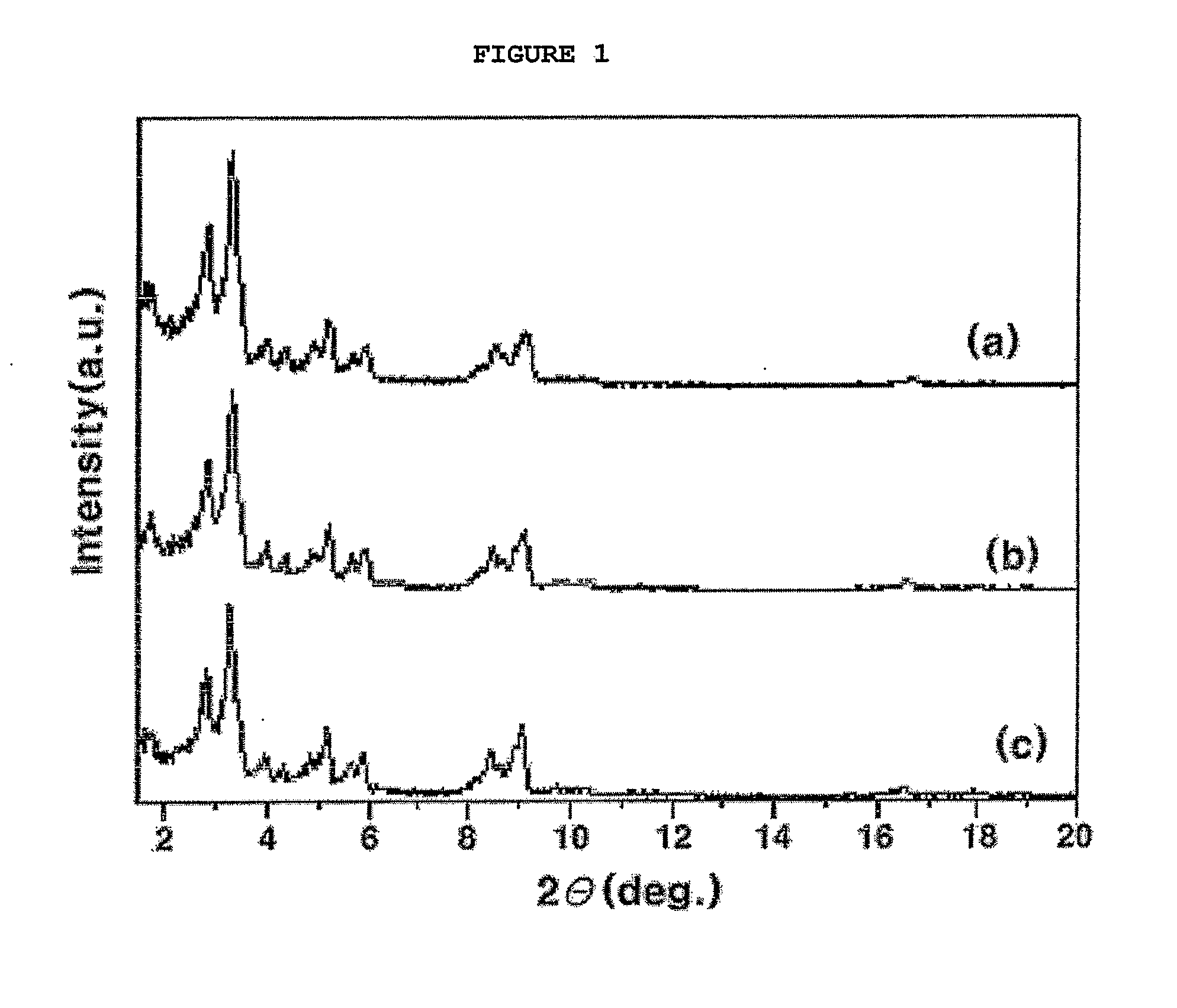Preparation of surface functionalized porous organic-inorganic hybrid materials or mesoporous materials with coordinatively unsaturated metal sites and catalytic applications thereof
a functionalized porous, organic-inorganic hybrid technology, applied in the field of nanoporous materials, can solve the problems of heterogeneous catalytic reactions conducted by functionalizing coordinatively, metals have not been reported, and the coordinative unsaturation is not easy to achiev
- Summary
- Abstract
- Description
- Claims
- Application Information
AI Technical Summary
Benefits of technology
Problems solved by technology
Method used
Image
Examples
preparation example 1
Preparation of Porous Organic-Inorganic Hybrid Material (MIL-101)
[0047]A porous organic-inorganic hybrid material (MIL-101) having a pore size of 1 nm or more was prepared (Science, 309, 2040, 2005).
[0048]Reactant mixtures with the molar composition for Cr:HF:BDCA:H2O=1:1:1:275 were prepared from Cr(NO3)3.9H2O, aqueous HF, 1,4-benzenedicarboxylic acid (BDCA) and water. The reactant mixtures were loaded in Teflon reactor, Subsequently, the reactant mixture was heated in an oven at a temperature of 220° C. for 8 hours to react, was cooled to room temperature, was separated using a centrifugal separator, was cleaned using distilled water, and was then dried at a temperature of 110° C., thereby obtaining the porous organic-inorganic hybrid material (MIL-101). The X-ray diffraction patterns (XRD patterns) of solids corresponded to those of the reported research (Science 2005, 309, 2040). The XRD pattern and oxygen adsorption isotherm of the obtained porous organic-inorganic hybrid materi...
preparation example 2
APS-SBA-15 Functionalized with Amino Group and Base Catalytic Reaction
[0049]SBA-15, which is a hexagonal silica mesoporous material, was prepared using a commonly known method, described in the document “J. Phys. Chem. 106, 255, 2002”. It was found that the XRD pattern of the baked SBA-15 was identical to that reported in the document. In Preparation Example 2, a porous material functionalized with an amino group (APS-SBA-15) was prepared as in Example 1, except that SBA-15, which is a mesoporous material, rather than an organic-inorganic hybrid material, was functionalized. As the result of a Knoevenagel condensation reaction, APS-SBA-15 was found to exhibit lower catalytic reactivity than NH2-MIL-101 in the same reaction time. The reason for this is that —NH2 group of NH2-MIL-101 was more activated than APS-SBA-15 (refer to Table 1).
example 1
ED-MIL-101 Functionalized with Amino Group
[0050]1 g of MIL-101, prepared in Preparation Example 1, was pretreated in a vacuum oven at a temperature of 200° C. for 12 hours to remove water coordinatively bonded to the coordinatively unsaturated metal sites thereof. Subsequently, 1 g of the dehydrated MIL-101 was put in a mixed solution of 2 ml of ethylenediamine (ED) and 48 ml of toluene. Subsequently, the mixed solution was refluxed at a temperature of 110° C. for 12 hours, separated by a paper filter, and then dried in an oven at a temperature of 110° C., thereby preparing a porous organic-inorganic hybrid material in which an amino group is coordinatively bonded to the coordinatively unsaturated metal sites thereof. From the X-ray diffraction pattern before / after the porous organic-inorganic hybrid material was supported with ethylenediamine, it could be seen that a material having the same structure as pure MIL-101 was obtained, as shown in (b) of FIG. 1. Further, from the result...
PUM
| Property | Measurement | Unit |
|---|---|---|
| Volume | aaaaa | aaaaa |
| Volume | aaaaa | aaaaa |
| Volume | aaaaa | aaaaa |
Abstract
Description
Claims
Application Information
 Login to View More
Login to View More - R&D
- Intellectual Property
- Life Sciences
- Materials
- Tech Scout
- Unparalleled Data Quality
- Higher Quality Content
- 60% Fewer Hallucinations
Browse by: Latest US Patents, China's latest patents, Technical Efficacy Thesaurus, Application Domain, Technology Topic, Popular Technical Reports.
© 2025 PatSnap. All rights reserved.Legal|Privacy policy|Modern Slavery Act Transparency Statement|Sitemap|About US| Contact US: help@patsnap.com



